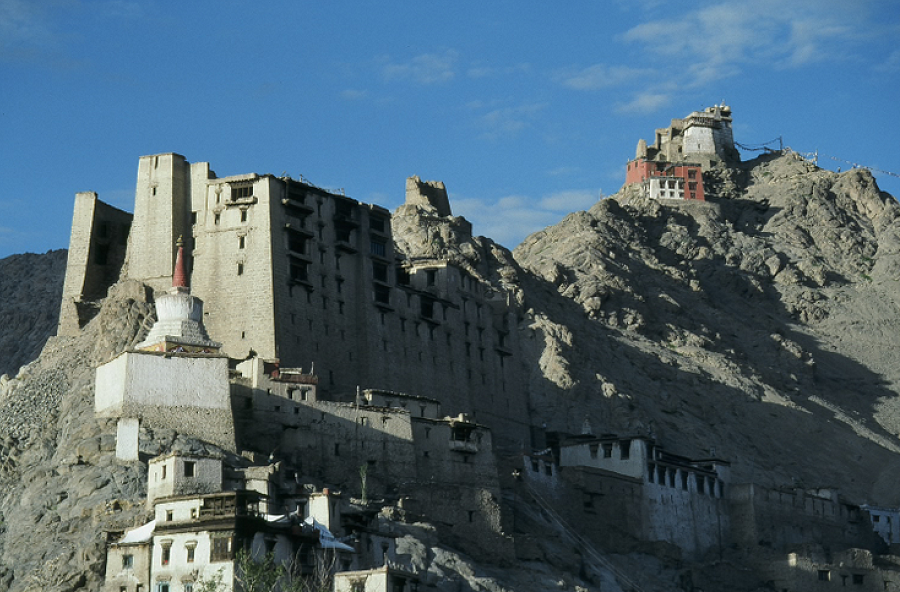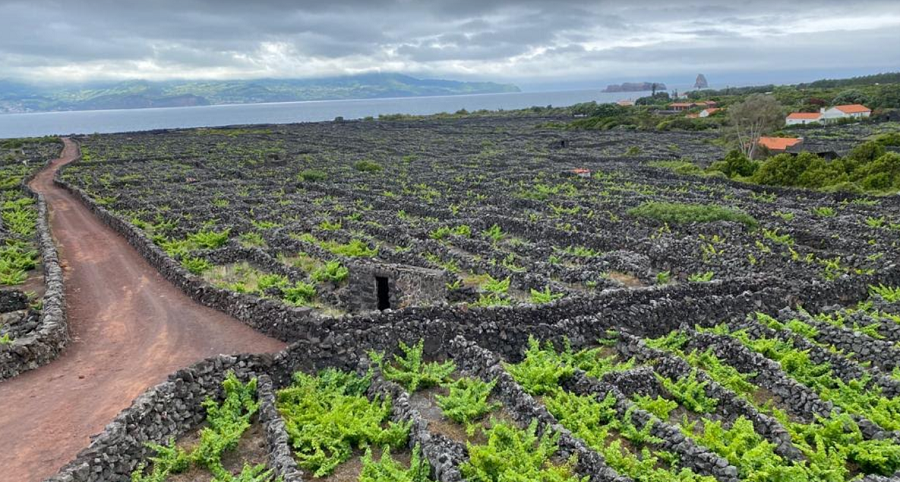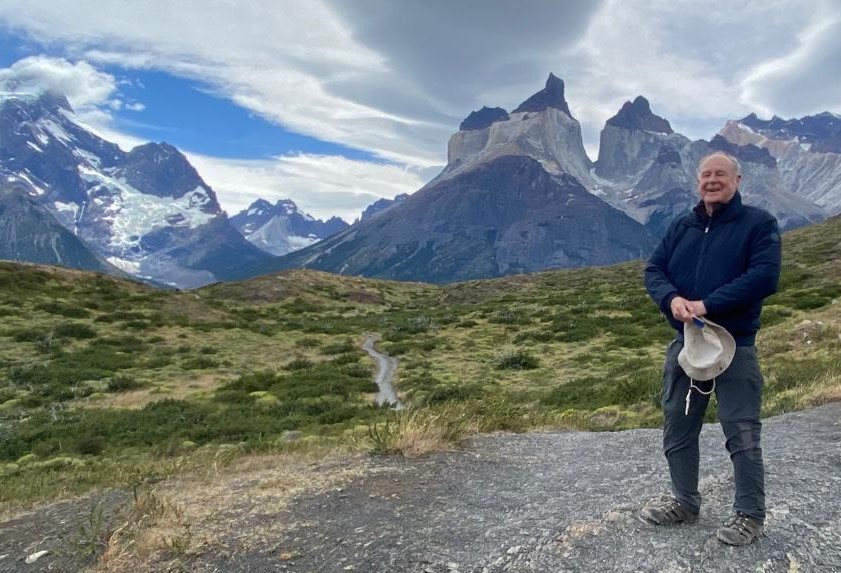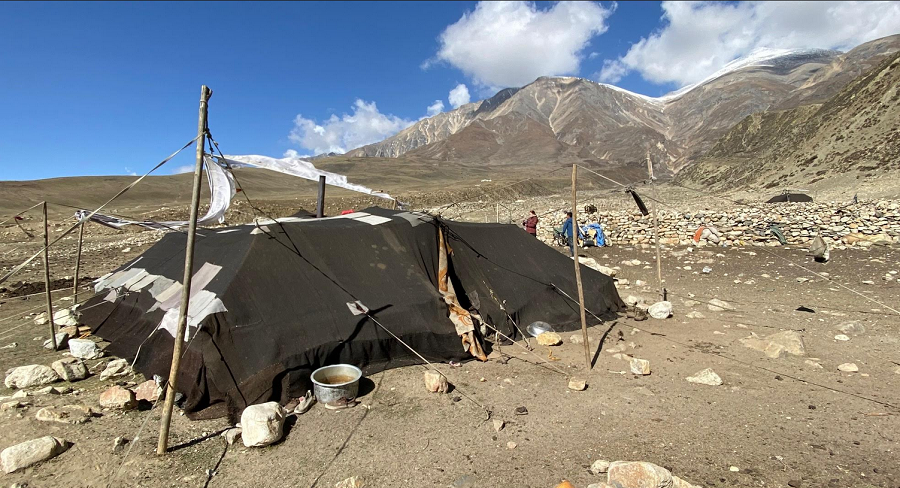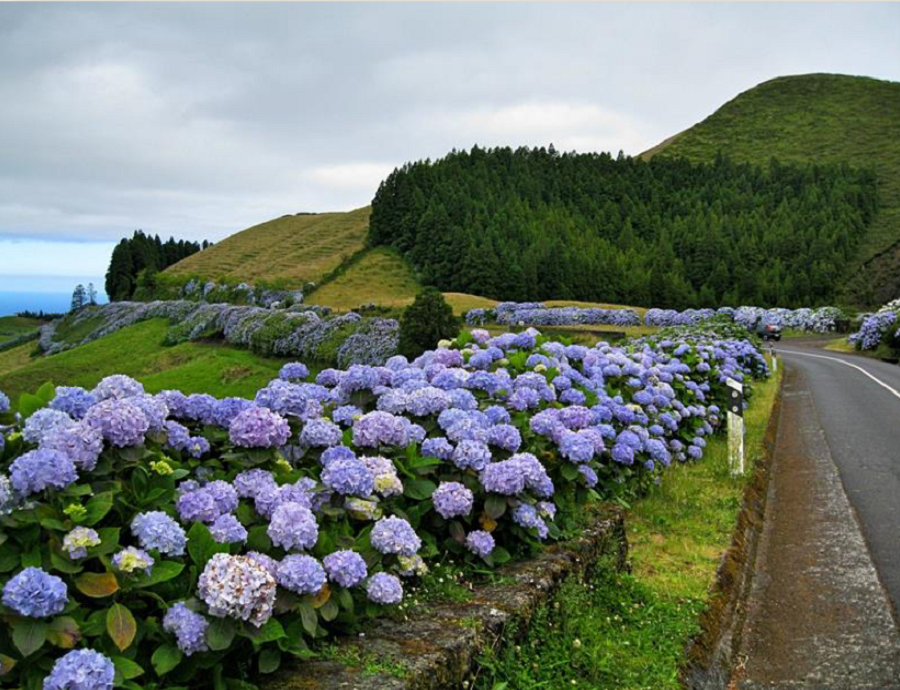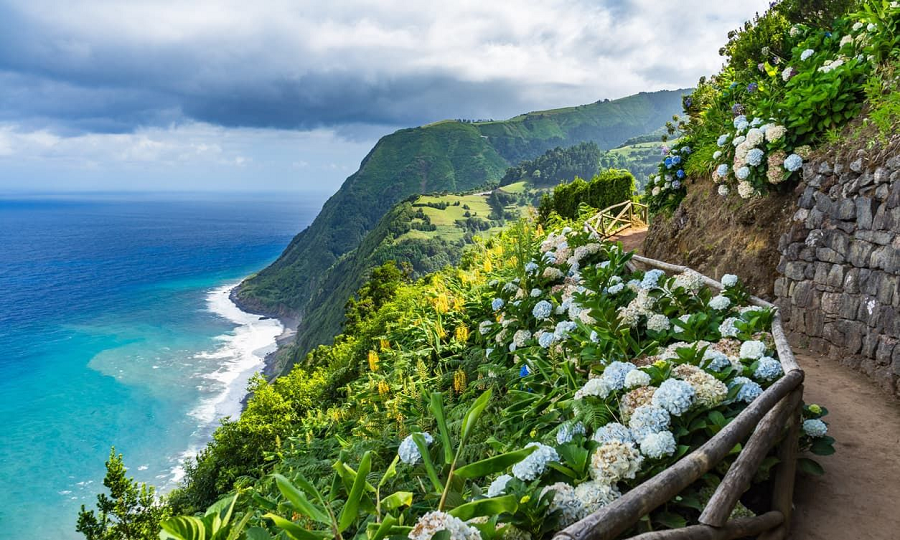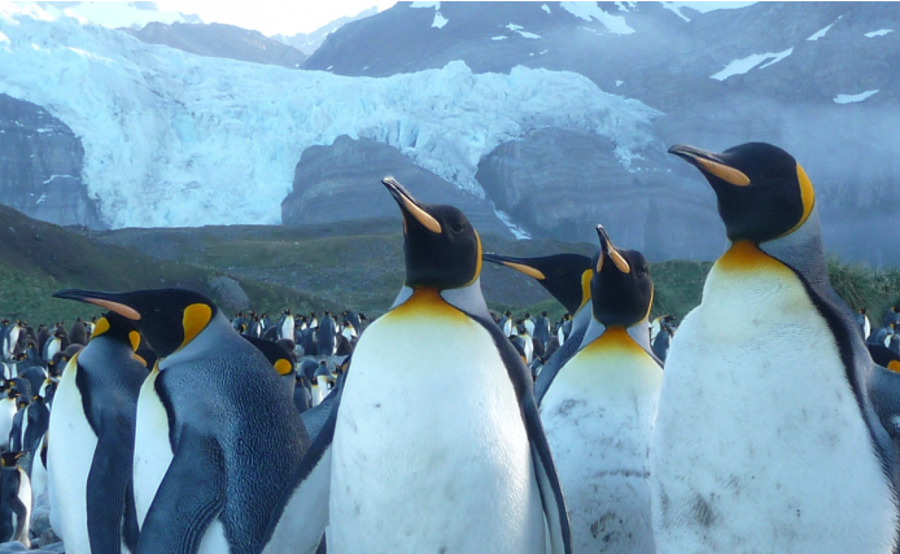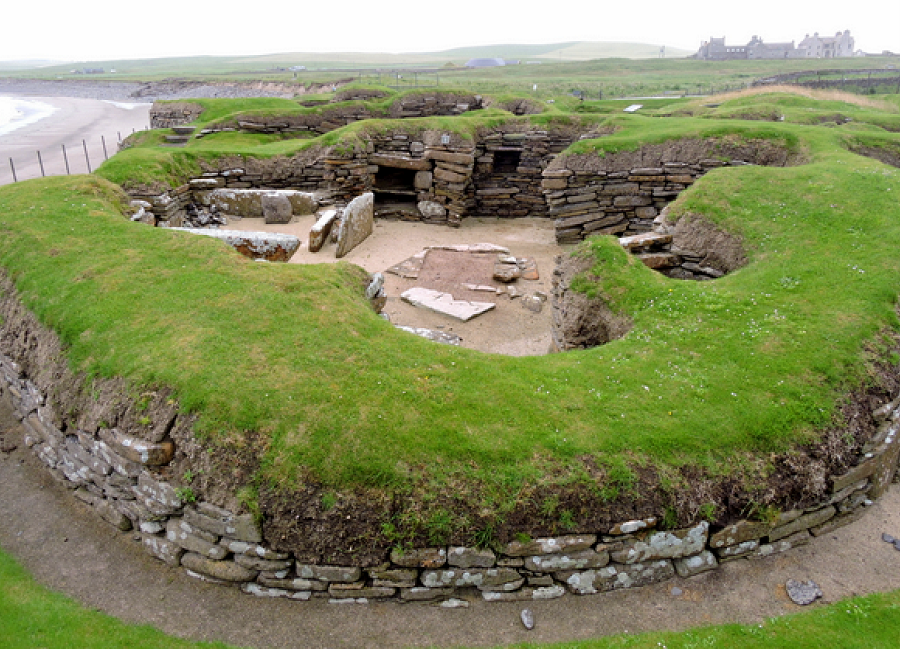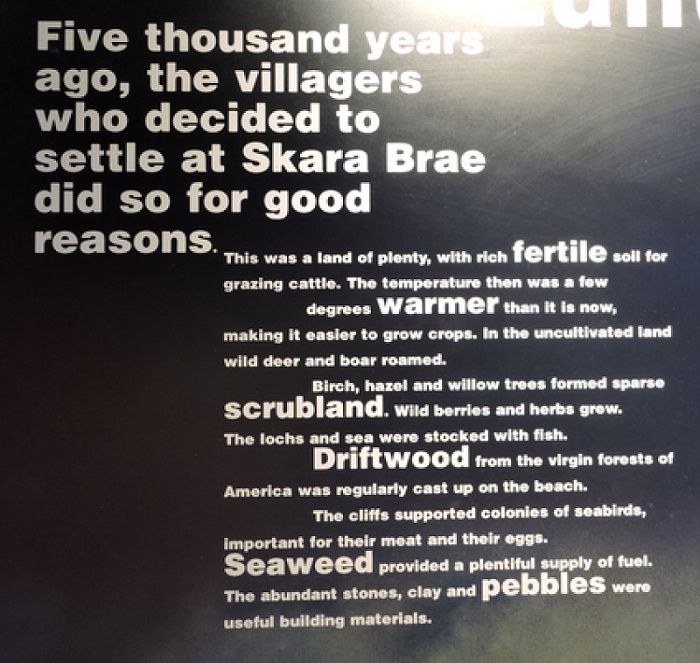Dr. Jack Wheeler
INDIAN TIBET
There is a part of Tibet the British kept from China and is now a part of India. The region is called Ladakh and this is its capital of Leh. It’s the Upper Indus river valley after it flows out of Chinese Tibet and before it reaches the Line of Control with Pakistan.
Ladakh is geographically and culturally Tibetan, where Tibetan culture still flourishes. Here the great gompas (monasteries) of Thikse and Hemis are active, and where you are welcome in hidden mysterious gompas like Lamayuru over a thousand years old.
There is an ultra-remote part of Ladakh called Zanskar where the Zanskar River flows through the crest of the Himalayas to reach the Upper Indus. Running the Zanskar is one of the world’s greatest whitewater experiences. We’ll see and do all of this next August on our Indian Tibet 2023 Expedition. Click on it and, trust me, the photos will blow you away. (Glimpses of Our Breathtaking World #120 Photo ©Jack Wheeler)
THE WORLD’S MOST UNUSUAL VINEYARD
The grape vines of Pico Island, one of nine islands of the Azores in the Atlantic, are enclosed within walls of black basalt rocks called currais (corrals). For over 500 years, the Portuguese villagers have been constructing thousands of miles of these currais walled enclosures to protect the vines from wind and sea spray.
The vineyards of Pico are so extraordinary that they are a UNESCO World Heritage Site. And the wine is uniquely good! You can order a bottle here. Best, though, is to experience Pico and its viticulture yourself. That’s what we did last June on our Atlantic Paradises adventure with your fellow TTPers.
We had a wonderful time – and you will too this coming June. You won’t believe how much adventurous fun you’ll have on our Atlantic Paradises 2023! Click to join us… (Glimpses of Our Breathtaking World #213 photo ©Jack Wheeler)
FLASHBACK FRIDAY: AFGHAN MUJAHADDIN?
 When my son Brandon was a cadet at Virginia Military Academy, his professor teaching Modern Military History gave a lecture on the 1980s War in Afghanistan fought by Afghan Mujahaddin against the Soviet Red Army occupation of their country. One of the pictures he showed was the one above of “three typical Mujahaddin fighters.”
When my son Brandon was a cadet at Virginia Military Academy, his professor teaching Modern Military History gave a lecture on the 1980s War in Afghanistan fought by Afghan Mujahaddin against the Soviet Red Army occupation of their country. One of the pictures he showed was the one above of “three typical Mujahaddin fighters.”
Brandon raised his hand. “Yes, Cadet Wheeler,” the professor called on him. “Actually, Professor,” Brandon said, “only the man in the center with the white beard is one. The man on the right is United States Congressman Dana Rohrabacher, while the man on the left is my father.”
The professor was stunned while the rest of the class stifled laughter. “Are you quite sure of that, Cadet Wheeler?” stammered the professor. “Oh, yes sir,” Brandon replied. “I recognize my own father. That photo is framed in my father’s study. It was taken in November 1988. The Afghan Commander’s name is Moli Shakur. I have known Congressman Rohrabacher all my life.”
The cadets all applauded in appreciation. To this day, this remains one of Brandon’s fondest college memories. (Glimpses of Our Breathtaking World #145 Photo ©Jack Wheeler)
HALF-FULL REPORT 01/20/23
Just got back home from the wilds of Patagonia since early January – such as being at the breathtaking Torres del Paine above – and can’t thank Mike Ryan enough for his spectacular HFR last week (1/13).
Thanks to Mike, TTPers were the first clued in to what others are figuring out this week. So now it’s my shout. Mike keeps raising the HFR bar on me. Let’s see if I can clear the bar now – here we go, and let’s have informative fun doing it.
A CHANGPA NOMAD GIRL ON THE TIBETAN PLATEAU
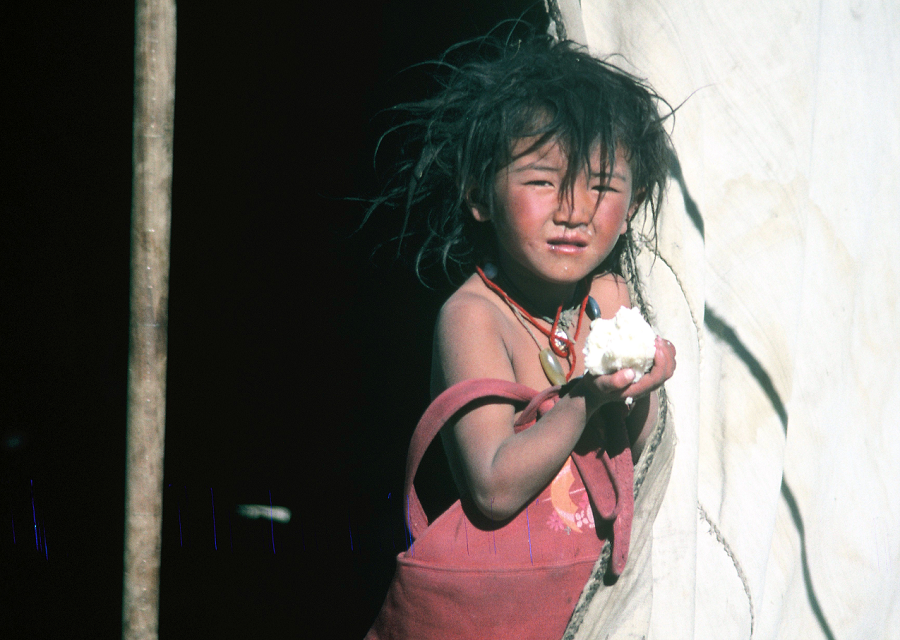 “Changpa” means “northerners” in Tibetan, the nomads who survive with their herds of goats and yaks in the 15,000-foot high plateau of northern Tibet known as the Changtang.
“Changpa” means “northerners” in Tibetan, the nomads who survive with their herds of goats and yaks in the 15,000-foot high plateau of northern Tibet known as the Changtang.
In 1987, I conducted an overland expedition from Beijing to Kathmandu, crossing the entire Changtang north to south. TTP’s Dr. Joel Wade was with me. Occasionally, we’d chance upon a Changpa encampment. For many of them such as this young girl holding a handful of barley meal, we were the first white people they had ever seen.
The Changpa live in one of the most remote and harshest places on earth. We can hardly imagine what life is like for them any more can they imagine ours. Being with them is an unforgettably profound experience. (Glimpses of Our Breathtaking World #254 photo ©Jack Wheeler)
COURTSHIP IN THE GALAPAGOS
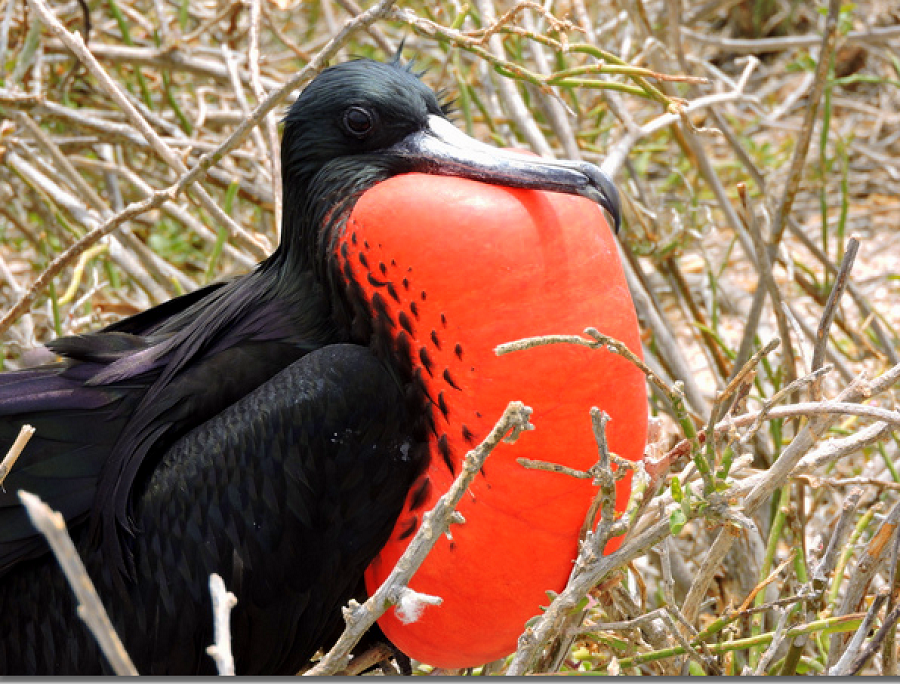 The male Magnificent Frigatebird has a flap of loose bright red skin on his neck called a “gular sac.” During mating season, they huff and puff, filling it with air to blow it up like a balloon. They then parade around showing off for the ladies, for the bigger the red balloon, the more the ladies are aroused. Size matters, even in the Galapagos.
The male Magnificent Frigatebird has a flap of loose bright red skin on his neck called a “gular sac.” During mating season, they huff and puff, filling it with air to blow it up like a balloon. They then parade around showing off for the ladies, for the bigger the red balloon, the more the ladies are aroused. Size matters, even in the Galapagos.
This is only one of many courtship displays among the birds and animals of these extraordinary islands. No wonder the Galapagos are called “evolution’s laboratory.” (Glimpses of Our Breathtaking World #199 photo ©Jack Wheeler)
NEGOTIABLE AFFECTION IN SKAGWAY
 When gold was discovered in the Klondike of Canada’s Yukon in 1896, the fastest way to get there was a tiny hamlet at the end of a long inlet of Alaska’s Inland Passage coast called Skagway. By 1898, Skagway was a lawless Wild West boom town flooded with prospectors who needed entertainment and release from the arduous travails of gold searching – and ladies who would provide it for a price.
When gold was discovered in the Klondike of Canada’s Yukon in 1896, the fastest way to get there was a tiny hamlet at the end of a long inlet of Alaska’s Inland Passage coast called Skagway. By 1898, Skagway was a lawless Wild West boom town flooded with prospectors who needed entertainment and release from the arduous travails of gold searching – and ladies who would provide it for a price.
The Brass Pic (as in a miner’s pic & shovel) was one of many Houses of Negotiable Affection in Skagway that flourished until the gold panned out in 1900. It’s preserved as a museum today in fond memory of those days of commercially consensual delight. Skagway is a terrific place to experience, drawing over a million visitors a year. Come here to see what draws them. (Glimpses of Our Breathtaking World #198 photo ©Jack Wheeler)
THE PERITO MORENO GLACIER
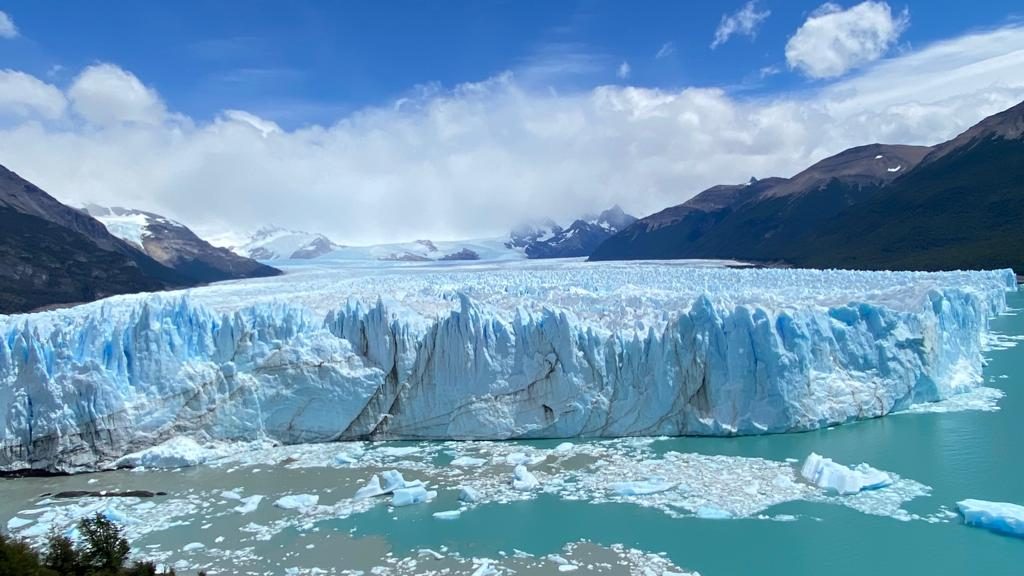 One of the most spectacular glaciers on earth, the Perito Moreno spills off the gigantic Southern Patagonia Ice Field constantly calving into Lago Argentino at the bottom of South America. It is almost 100 square miles of ice some 600 feet thick, and is an embarrassment to climate alarmists because it’s growing, not retreating. Every day, huge chunks of ice on the glacier’s front (which you see in the photo) break off or “calve” into the lake, equal to the glacier’s forward advance of two meters or over six feet a day.
One of the most spectacular glaciers on earth, the Perito Moreno spills off the gigantic Southern Patagonia Ice Field constantly calving into Lago Argentino at the bottom of South America. It is almost 100 square miles of ice some 600 feet thick, and is an embarrassment to climate alarmists because it’s growing, not retreating. Every day, huge chunks of ice on the glacier’s front (which you see in the photo) break off or “calve” into the lake, equal to the glacier’s forward advance of two meters or over six feet a day.
Thunderous cracks and booms accompany the plunge of the calved sections with huge splashes of water. You never know when or where they’ll occur along the mile wide front, but when they do, everyone watching exclaims and applauds. We were lucky to have perfectly gorgeous weather. You can take a boat along the front, view it from several boardwalks for marvelous vantage points, or even hike on it with crampons with an ice-trekking guide. Being here is one of Patagonia’s most thrilling experiences.
(Glimpses of Our Breathtaking World #253 photo ©Jack Wheeler)
FLASHBACK FRIDAY: GOLD-PLATED LAUGHTER WITH AN UZBEK LADY
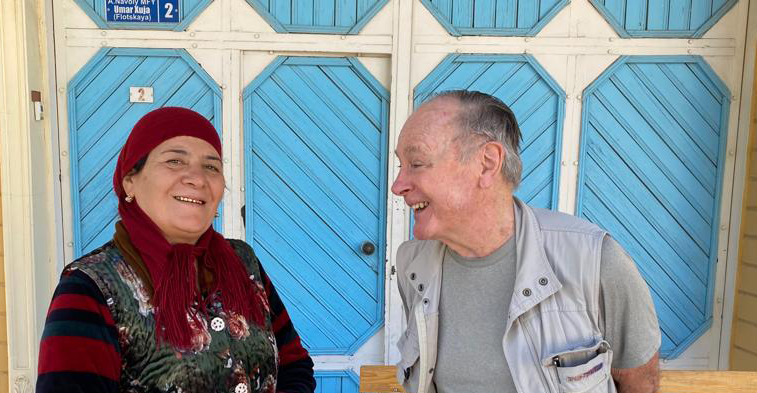 In Bukhara, Uzbekistan, I didn’t speak Uzbek and she didn’t speak English, yet laughter is the true universal language.
In Bukhara, Uzbekistan, I didn’t speak Uzbek and she didn’t speak English, yet laughter is the true universal language.
She gave me a broad smile to display her gold-plated teeth. You don’t often see someone with teeth of gold, but she says what better way to protect your teeth when you’re getting old? The Uzbek people of Central Asia have a wonderful sense of humor. Come with me to Central Asia this September to laugh with these Silk Road people yourself. (Glimpses of Our Breathtaking World #252 photo ©Jack Wheeler)
CERRO CAMPANARIO
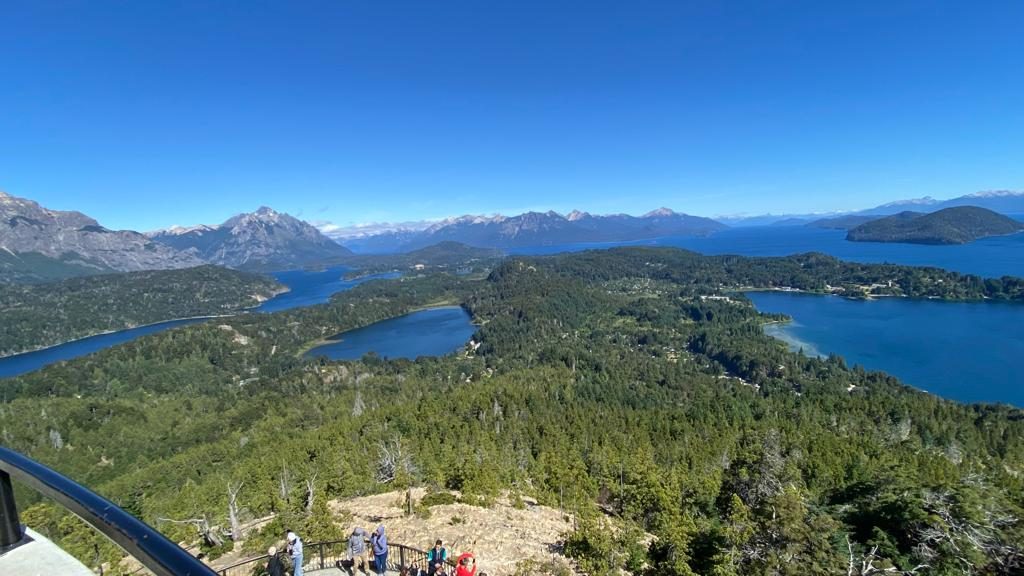 This is the view of the lakes of Bariloche in Argentine Patagonia. It was taken yesterday from a viewpoint called Cerro Campanario. This really is one of the most beautiful places on Earth. I'm here exploring Patagonia with your fellow TTPers. Wish you were here with us!
This is the view of the lakes of Bariloche in Argentine Patagonia. It was taken yesterday from a viewpoint called Cerro Campanario. This really is one of the most beautiful places on Earth. I'm here exploring Patagonia with your fellow TTPers. Wish you were here with us!
(Glimpses of Our Breathtaking World #251 photo ©Jack Wheeler)
IS THIS THE WORLD’S MOST BEAUTIFUL BEACH?
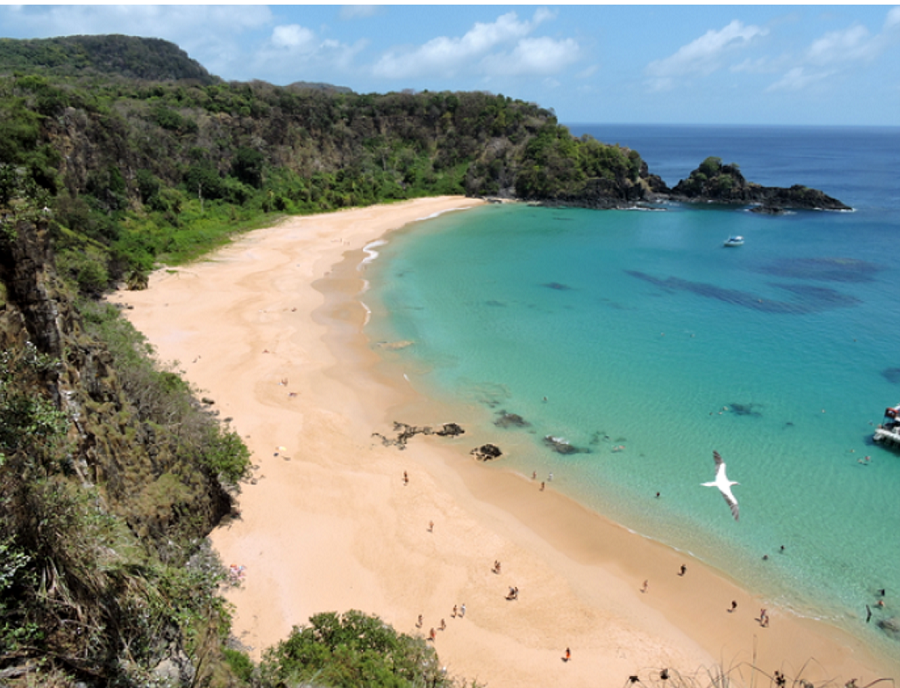 According to the many thousands of world travellers on TripAdvisor, it’s #1: Praia do Sancho on the Brazilian island of Fernando de Noronha. You’ll also find it on just about any list of most beautiful beaches, such as Condé Nast, Harper’s Bazaar, and Luxury Travel.
According to the many thousands of world travellers on TripAdvisor, it’s #1: Praia do Sancho on the Brazilian island of Fernando de Noronha. You’ll also find it on just about any list of most beautiful beaches, such as Condé Nast, Harper’s Bazaar, and Luxury Travel.
The whole island is gorgeous. Mention that you’ve been there to any Brazilian who hasn’t and their eyes get misty. Fernando de Noronha (no-rone-ya) is the dream honeymoon, the dream vacation that only comes true for few in Brazil, as it’s hard to get to and hardly any place to stay once you’re there.
You have to get to either Recife or Natal in the far northeast, then fly 220 miles out into the Atlantic. Then take a boat, or scamper down the rocks of a 250ft-high cliff to be on the sugar sand of this enchanting beach – which you’ll have almost to yourself.
For some reason, all those lists have the name wrong, calling it “Baia” or “Baio,” when it’s “Praia” (beach in Portuguese). As the welcome sign proudly announces above the cliff trail: “Praia do Sancho – A Mais Bonita do Mundo,” Sancho Beach – The Most Beautiful in the World. If you’re lucky to ever get here, you’ll surely agree. (Glimpses of Our Breathtaking World #73 photo ©Jack Wheeler)
THE DANCING FOREST ON THE CURONIAN SPIT
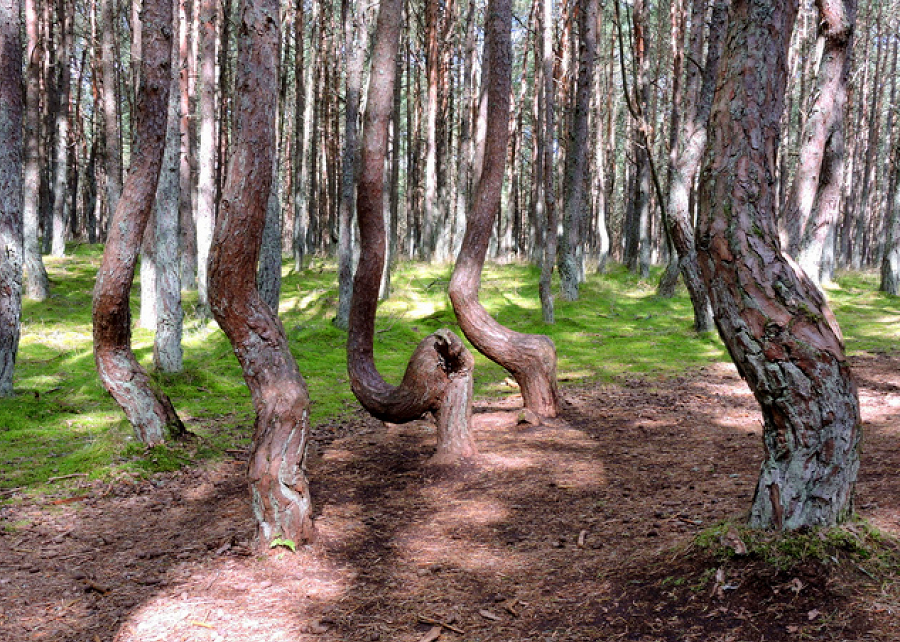 The Curonian Spit is a 60 mile-long and skinny stretch of sand separating the 625 square-mile Curonian Lagoon from the Baltic Sea. It is jointly shared by Lithuania and Kaliningrad. The trees of one section of the pine forests covering the spit are weirdly twisted and distorted by some unknown force of nature. Their bizarre undulations have earned it the sobriquet, “The Dancing Forest.” It’s one of the as-yet unexplained mysteries of life on our planet, and a wondrous one to see. (Glimpses of Our Breathtaking World #200 photo ©Jack Wheeler)
The Curonian Spit is a 60 mile-long and skinny stretch of sand separating the 625 square-mile Curonian Lagoon from the Baltic Sea. It is jointly shared by Lithuania and Kaliningrad. The trees of one section of the pine forests covering the spit are weirdly twisted and distorted by some unknown force of nature. Their bizarre undulations have earned it the sobriquet, “The Dancing Forest.” It’s one of the as-yet unexplained mysteries of life on our planet, and a wondrous one to see. (Glimpses of Our Breathtaking World #200 photo ©Jack Wheeler)
A CUP OF YAK BUTTER TEA IN A TIBETAN NOMAD TENT
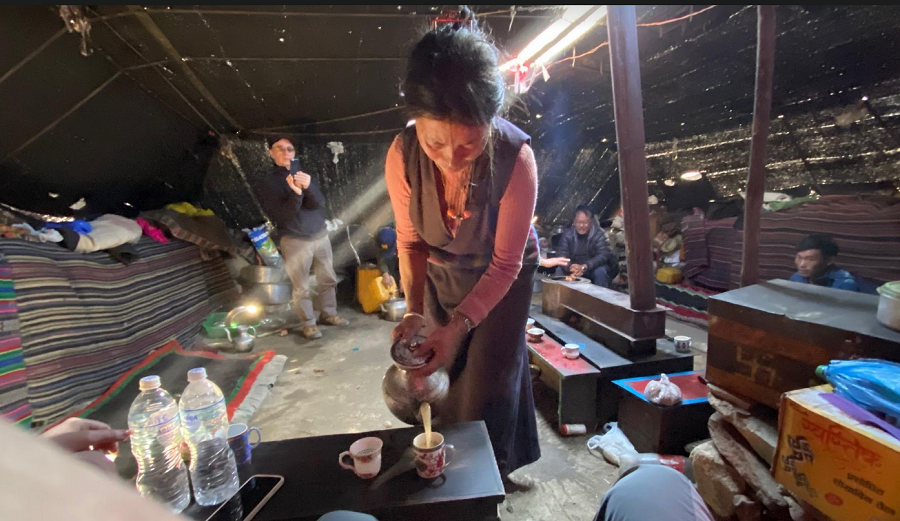 At 14,000 feet, Tibetan nomads called Drogpa set their summer encampment for their yak herds to graze on green pastures. You find them with difficulty in the remote Himalayan highlands of the Kingdom of Lo. They are happy to welcome you into their home, a single large tent of black yak wool, and serve you a cup of delicious yak butter tea.
At 14,000 feet, Tibetan nomads called Drogpa set their summer encampment for their yak herds to graze on green pastures. You find them with difficulty in the remote Himalayan highlands of the Kingdom of Lo. They are happy to welcome you into their home, a single large tent of black yak wool, and serve you a cup of delicious yak butter tea.
It is a rare privilege to be with these people and experience their ancient way of life. It is something we strive to do on our Himalaya Helicopter Expeditions. I took this picture in May. Here is their home from the outside. (Glimpses of Our Breathtaking World #203 photo ©Jack Wheeler)
HALF-FULL REPORT 01/06/23
 Buenos Aires, Argentina. I am sending this first HFR of 2023 to you from the capital of Argentina at the start of our Patagonia Wonderland exploration with your fellow TTPers.
Buenos Aires, Argentina. I am sending this first HFR of 2023 to you from the capital of Argentina at the start of our Patagonia Wonderland exploration with your fellow TTPers.
It’s an unbeatable way to start a new year: with an unforgettable adventure in an extraordinary part of the world far away from home. Particularly now – for it’s a great way to say goodbye and good riddance to the rubbish year of 2022. Into the trash can of history it goes.
That’s a very full trash can. In November, America – Dem cheating making the difference on the margin notwithstanding – voted for more crime, more CRT, more forced child tranny change, more inflation, more woke lunacy, more corruption, the list of nightmares goes on. It's a patient dying of a terminal disease who doesn't want to be cured, who wants to die instead.
So what’s in store for us and the world in 2023? We’re going to start with who will be the biggest Winners and Losers of 2023, then identify the fundamental key to whether a country will flourish and prosper, or decline and suicide itself. That most certainly applies to the USA. And yes, all this involves the three books above.
FLASHBACK FRIDAY – THE MAN-EATER OF DALAT
 Dalat, South Viet Nam, 1961. I was 17 years old. A friend of my father’s, Herb Klein, came by our house. He was a prominent businessman whose passion was big-game hunting. He had just returned from the mountain jungle highlands of South Viet Nam and regaled us with stories of the Montagnard tribespeople who were plagued by tigers with a taste for human flesh. He told me that after climbing the Matterhorn, living with Amazon headhunters, and swimming the Hellespont, hunting a man-eating tiger should be my next adventure.
Dalat, South Viet Nam, 1961. I was 17 years old. A friend of my father’s, Herb Klein, came by our house. He was a prominent businessman whose passion was big-game hunting. He had just returned from the mountain jungle highlands of South Viet Nam and regaled us with stories of the Montagnard tribespeople who were plagued by tigers with a taste for human flesh. He told me that after climbing the Matterhorn, living with Amazon headhunters, and swimming the Hellespont, hunting a man-eating tiger should be my next adventure.
“You’d be saving so many lives, Jack,” he told me. “There’s one I heard about from the Co Ho Montagnards that’s killed and eaten almost 20 of them in the forests outside the town of Dalat. I know who can guide you, he was mine, his name is Ngo Van Chi.”
Somehow, I talked my parents into letting me do this. I had saved up the money from giving tennis and judo lessons. So there I was, in pitch dark in a “mirador” of branches and leaves, holding a .300 Weatherby with a flashlight wired to the barrel, waiting for this man-eating tiger to come for the rotting water buffalo we set out as bait. Chi and I heard the tiger, I put the rifle barrel out, Chi clicked on the flashlight, I saw these two enormous red eyes, and fired.
And there he is, the Man-Eater of Dalat, who would never kill another human being ever again. (Glimpses of Our Breathtaking World #175 photo ©Jack Wheeler)
HEAVEN IN THE CARIBBEAN
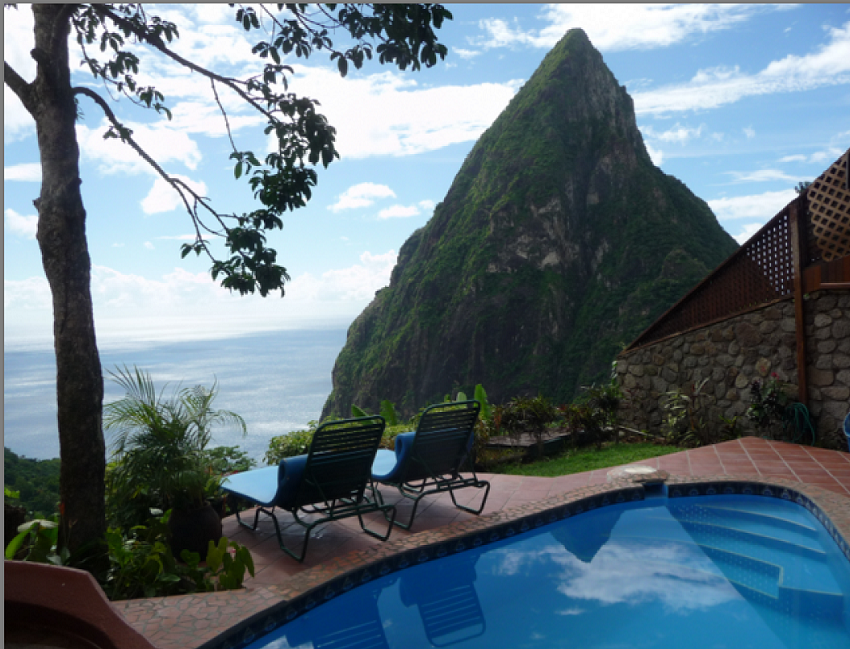 Quick – name the only country in the world named after a woman. It’s the island nation in the Caribbean of St. Lucia, named after the patron saint of virgins, 4th century Saint Lucia.
Quick – name the only country in the world named after a woman. It’s the island nation in the Caribbean of St. Lucia, named after the patron saint of virgins, 4th century Saint Lucia.
The charm, beauty, and serenity of St. Lucia are unequaled in the Caribbean. Here you can have your own private retreat overlooking the twin peaks of The Pitons. The St. Lucian people take great pride in the immaculate spotlessness of their island and in their matchless reputation for personal warmth and hospitality.
While an English-speaking country and member of the British Commonwealth, there is a French tradition here as well, reflected in the fine cuisine and wines in restaurants. Yet I became fond of the local Piton beer as well. St. Lucia is the easiest island in the Caribbean to fall in love with – so it is no wonder that couples come from all over the world to get married or honeymoon here.
If you want to spend a few days of bliss away from all the cares of the world, you can’t do better than this place of heaven in the Caribbean. (Glimpses of Our Breathtaking World #190 photo ©Jack Wheeler)
FLOWER HIGHWAYS, FLOWER TRAILS
For miles and miles, the roads in the Azores Islands are lined with flowers on both sides. Even the foot paths and trails are strewn with flowers.
As you know, I’ve been to every country in the world. I know of no place on earth more beautiful, more flower strewn, more peaceful, serene, and safe than Portugal’s island paradises of Madeira and the Azores in the Atlantic.
So plan on joining me, Rebel, and your fellow TTPers on our exploration of Atlantic Paradises, June 17 to 25. Make this beauty and serenity a part of your life. (Glimpses of Our Breathtaking World #196 photo ©Jack Wheeler)
THE EUROPE THATS STILL THERE
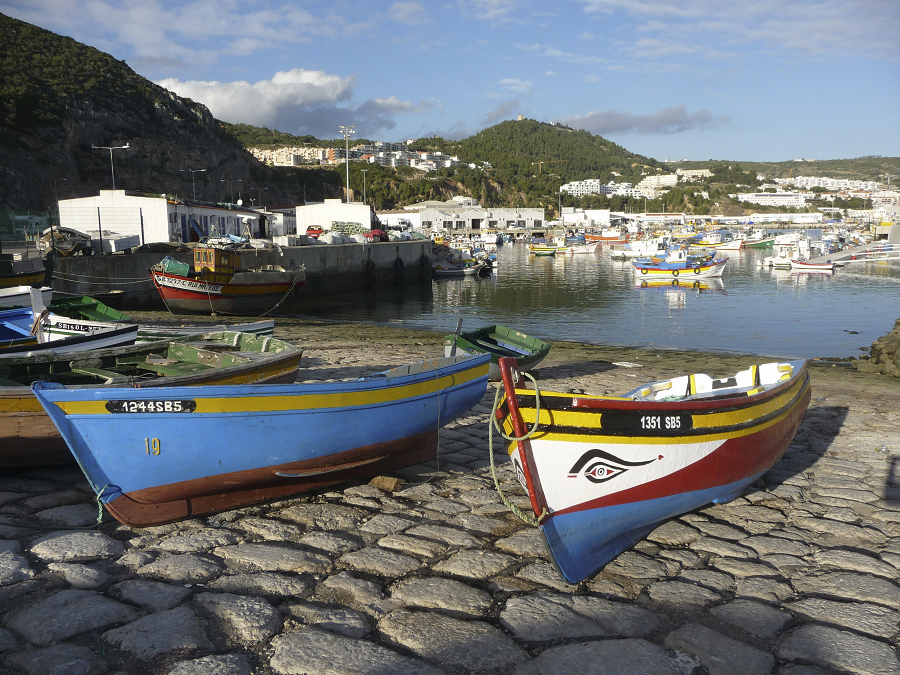 It’s found here – the fishing port of the ancient village of Sesimbra in Portugal. 3,000 years ago it was called Sempsibriga – high place or briga of the Sempsi Celts. So much of Europe is gone now, steamrollered by modernity. Not here, where Portuguese fishermen sail out in their tiny boats for their daily catch as they have for countless generations. The best fish you’ve ever had is in Sesimbra’s local restaurants – wow, is the swordfish good.
It’s found here – the fishing port of the ancient village of Sesimbra in Portugal. 3,000 years ago it was called Sempsibriga – high place or briga of the Sempsi Celts. So much of Europe is gone now, steamrollered by modernity. Not here, where Portuguese fishermen sail out in their tiny boats for their daily catch as they have for countless generations. The best fish you’ve ever had is in Sesimbra’s local restaurants – wow, is the swordfish good.
While Portugal is a First World country with all the modernity you could ask for, it is unique not only for the charm of its history, preservation of its culture, and post-card picturesqueness, but the sweetness of its people. They are simply nice in a way that’s so captivating. Their traditional family values are part of their nature. The country resonates with peacefulness, an at ease serenity. It’s the Europe that’s still there.
You can be captivated yourself by joining our WX Exploration of Portugal next month, June 17-26. (Photo ©Jack Wheeler)
Jack Wheeler is Escape Artist’s World Exploration Expert. He is the founder of Wheeler Expeditions at WheelerExpeditions.com.
TURNING 80
I turn 80 years old this year of 2023. It’s a sobering milestone.
I have almost infinitely more to be grateful for than not. I have had an incredible life, lucky beyond belief. I have the two most wonderful sons a father could ask for. As Rebel and I are in our fourth decade of marriage, we love each other more than ever.
And I am in superb health – albeit with that infamous qualifier, “for my age.” I work out several days a week so hard and extensively that a friend recently told me he’s seen fit 40 year-olds in the gym that couldn’t keep up with me. I don’t have an ache or pain in my body.
However… as 80 looms before me, I realize I can’t keep this up. At some point, I’m going to have to call it a day. So I’ve decided that I’m going to give it my all for another year – that year being this one, 2023.
I’m always saying, Carpe Diem – the Time for a Great Adventure Is Now. Well, that time has come. If you’ve always wanted to have a great adventure with me in some awesomely cool place in the world – or have another! – carpe diem, seize the day.
To entice you, I’ve made another decision: to make you a deal I hope you can’t resist.
RESOLUTIONS 2023
 Rebel and I received the best Christmas present we could ask for. Jackson and his wife Raya came to spend Christmas-New Year’s with us, and to deliver the news: Rebel and I are going to be grandparents! At last!
Rebel and I received the best Christmas present we could ask for. Jackson and his wife Raya came to spend Christmas-New Year’s with us, and to deliver the news: Rebel and I are going to be grandparents! At last!
The picture you see is Rebel, Jackson, and me standing in front of our Christmas tree, with Rebel holding a 1992 photo of Jackson being held by us on his first Christmas at six months old. He’s now 30, six-foot-two, and soon to be a father himself.
The years pass by so quickly. You look back on them and they seem to have gone by at light speed. That’s why I always advise parents of young children to treasure every day with them – for the day will come so fast when they will be grown and gone.
That’s why each one of us no matter how old should treasure every day we are still alive on this Earth – for the day will come when we will be gone, and that day can come at any moment.
That’s why every January 1st, I renew my two most fundamental Resolutions for the coming year. Here they are – and I’d like to suggest they be yours too.
FLASHBACK FRIDAY: THE SKY CAVES OF MUSTANG
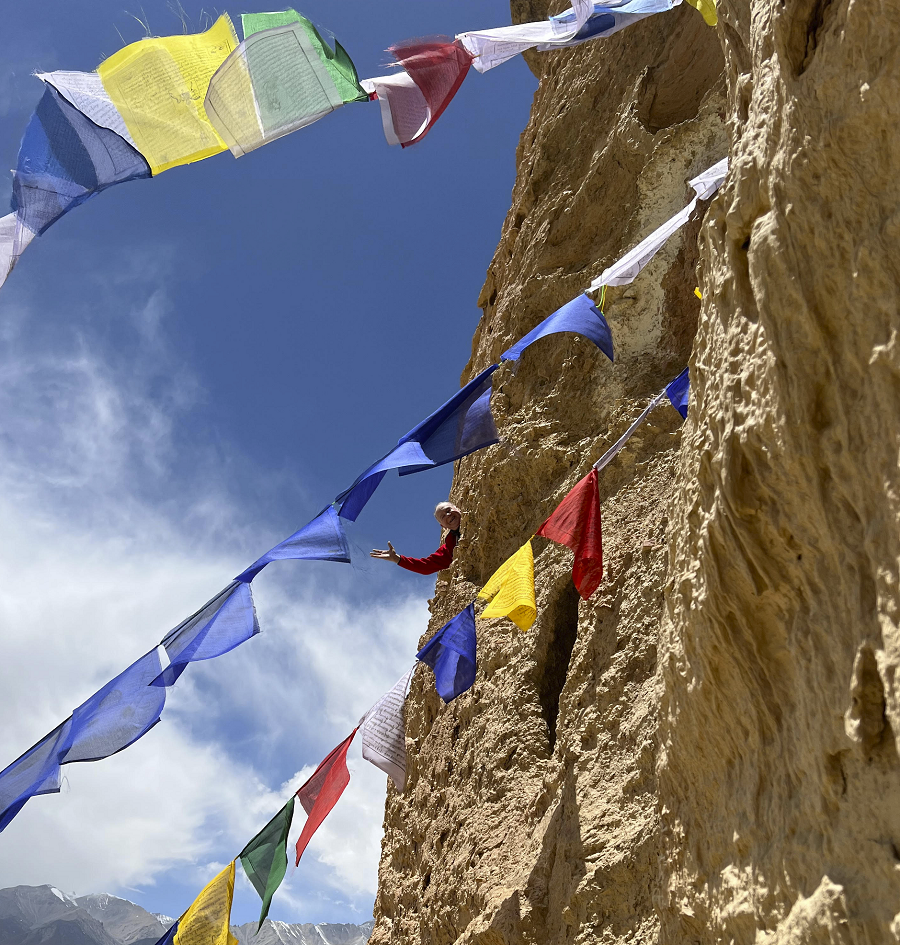 Yes, that’s me, waving from one of the cave openings on the cliff face honeycombed with 2,000 year-old Sky Caves in a remote region of the Himalayas called Upper Mustang. The photo was taken by one of your fellow TTPers on our most recent Himalaya Helicopter Expedition last May.
Yes, that’s me, waving from one of the cave openings on the cliff face honeycombed with 2,000 year-old Sky Caves in a remote region of the Himalayas called Upper Mustang. The photo was taken by one of your fellow TTPers on our most recent Himalaya Helicopter Expedition last May.
Upper Mustang is ruled by the Tibetan Kingdom of Lo, created by Tibetan warrior-king Amne Pal in 1380, with its sovereignty protected today by Nepal from the Chicoms right across the border in Chinese-Occupied Tibet. Lo, with its capital the medieval walled city of Lo Manthang, is where you will find the most traditional Tibetan culture left on our planet.
You can experience it yourself on our Himalaya Helicopter Expedition this spring. If not now, when? Carpe diem.
(Glimpses of Our Breathtaking World #250 photo ©Jack Wheeler)
THE CASTLE PRISON OF RICHARD THE LIONHEART
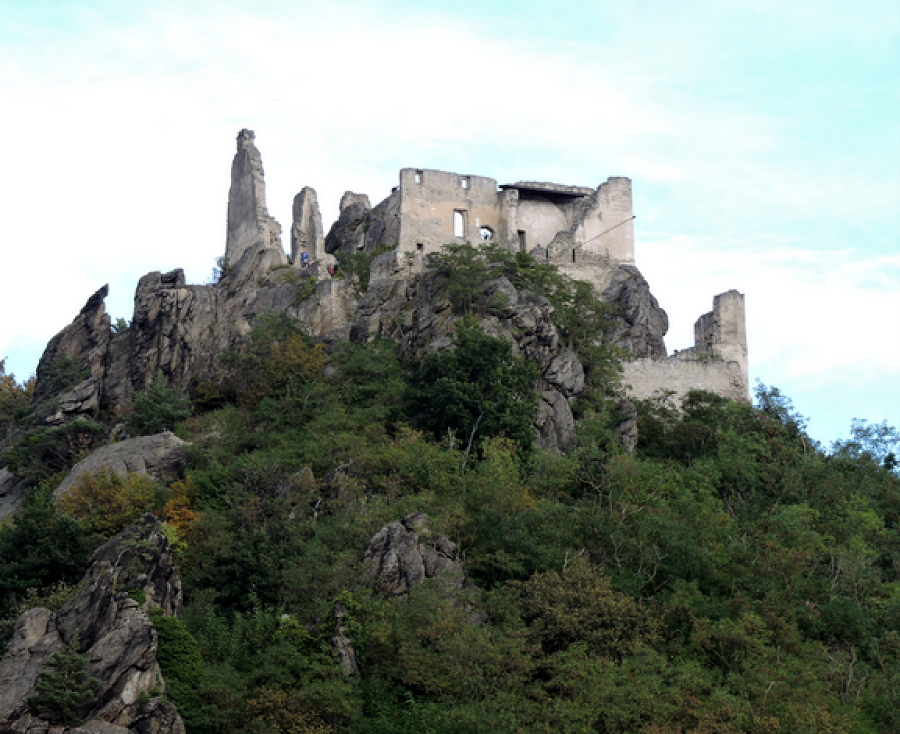 This is Durnstein Castle, perched on a precipice high above the Danube River in Austria some 60 miles upriver from Vienna. Built in the early 1100s, here is where King of England Richard the Lionheart was imprisoned, having been captured by his enemy Leopold V of Austria on his return from the Third Crusade in the Holy Land.
This is Durnstein Castle, perched on a precipice high above the Danube River in Austria some 60 miles upriver from Vienna. Built in the early 1100s, here is where King of England Richard the Lionheart was imprisoned, having been captured by his enemy Leopold V of Austria on his return from the Third Crusade in the Holy Land.
The story is well known of how Richard’s brother John had usurped the throne and impeded paying Richard’s ransom – and the legend of Robin Hood raising the money pilfering it from thieving nobles. The ransom was finally paid in 1194, with Richard returning to be crowned King of England once again. The castle fell into disrepair, uninhabitable since the late 1600s. It is an eerie journey back into history to explore it today. (Glimpses of Our Breathtaking World #197 photo ©Jack Wheeler)
THE LION ROCK OF SIGIRIYA
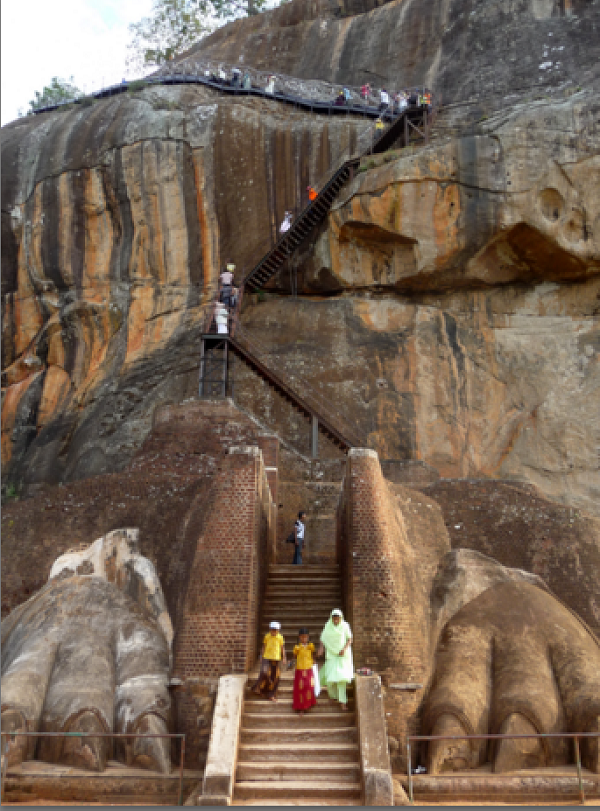 Rising 600 feet above the jungles of central Ceylon (Sri Lanka) is a gigantic rock column revered for millennia as Sigiriya – Lion Rock from Sanskrit. It’s flat on top, used over centuries as a Buddhist monastery and a fortress by kings. In 480, King Kashyapa had the image of a lion carved into the rock as the entrance gate to his fortress-palace on top. All that’s left are the lion’s paws that you see.
Rising 600 feet above the jungles of central Ceylon (Sri Lanka) is a gigantic rock column revered for millennia as Sigiriya – Lion Rock from Sanskrit. It’s flat on top, used over centuries as a Buddhist monastery and a fortress by kings. In 480, King Kashyapa had the image of a lion carved into the rock as the entrance gate to his fortress-palace on top. All that’s left are the lion’s paws that you see.
It was a risky climb via stone stairs carved into the rock getting to the top. Today there’s a much safer wooden staircase. It’s a pilgrimage site for Sri Lankans where they get to celebrate their history and enjoy the gorgeous view on top. It’s a marvelous experience for you to participate in. (Glimpses of Our Breathtaking World #158 photo ©Jack Wheeler)
AMONG A MILLION PENGUINS IN SOUTH GEORGIA
The Antarctic island of South Georgia is home to a million King penguins, plus countless fur seals, gigantic elephant seals, staggering numbers of seabirds such as albatrosses, amidst a backdrop of towering mountains with massive glaciers spilling off them.
Nothing can prepare you for the incomprehensible size of the penguin rookeries here, densely packed as far as the eye can see (all those white dots on the hills behind are penguins). Nor for the size of bull elephant seals weighing up to 8,000 pounds, especially when they rise up and crash their chests against each other in mating challenges emitting deafening bellows. Nor being surrounded by a thousand fur seals unafraid of you. The density of wildlife combined with the magnificent beauty of the island is completely overwhelming.
Here also is the abandoned whaling station of Grytviken where the heroic explorer Ernest Shackleton is buried. You can only get here by expedition cruise ship. South Georgia is one of the great experiences on our planet. (Glimpses of Our Breathtaking World #96 photo ©Jack Wheeler)
MAURITANIA FISH MARKET
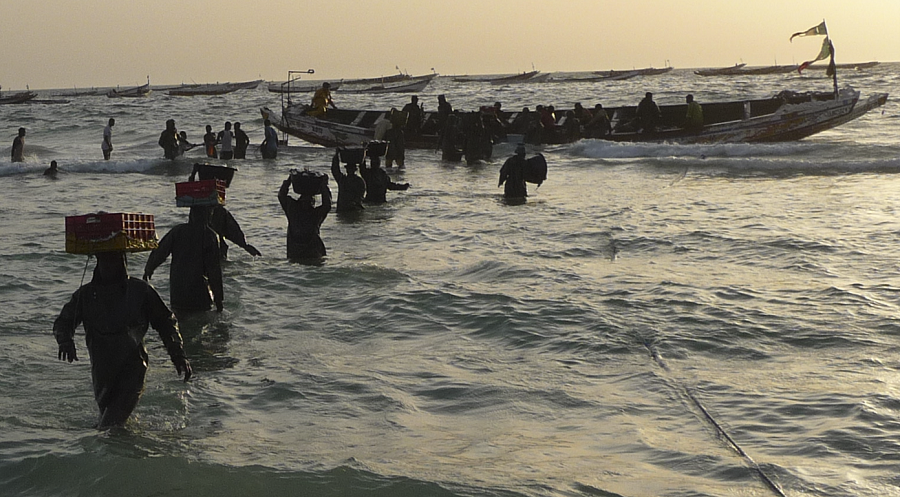 Go down to the Atlantic coast beach of Mauritania’s capital Nouakchott at sunset, and you’ll see a very unusual fish market. A fishing boat laden with the day’s catch is ready to come ashore, but the crew is afraid the wind and surf may capsize the boat as they do, losing their catch in the process.
Go down to the Atlantic coast beach of Mauritania’s capital Nouakchott at sunset, and you’ll see a very unusual fish market. A fishing boat laden with the day’s catch is ready to come ashore, but the crew is afraid the wind and surf may capsize the boat as they do, losing their catch in the process.
So they float just outside the surf line so buyers with boxes and baskets can wade out to buy the fish right off the boat, and wade back. Only when the boat is empty will the crew attempt to beach it. Just one of this West African country’s intriguing sights.
.(Glimpses of Our Breathtaking World #249 photo ©Jack Wheeler)
FLASHBACK FRIDAY – TIGER LEAPING GORGE
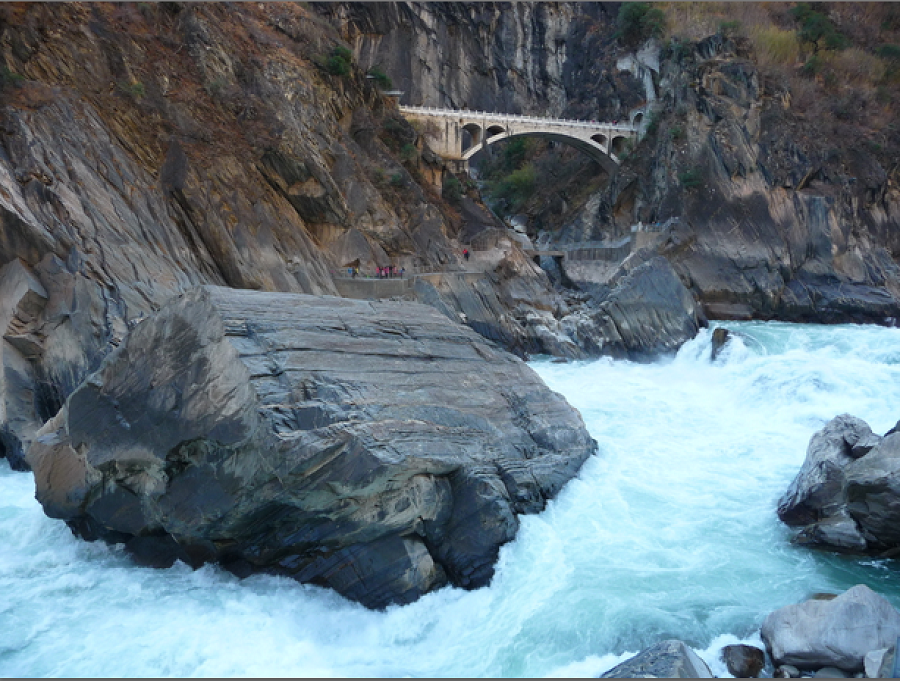 Many centuries ago, a tiger was plaguing the Naxi people who live in the mountains where the Yangtse River cascades off the plateau of Tibet. He was eating the goats the Naxi needed to feed themselves. So Naxi hunters chased the tiger into a deep narrow gorge of the Yangtse where they were sure they had him trapped. Suddenly, the tiger sprang onto a large rock in the center of the raging river and from there leapt to the other side and escaped, never to be seen again.
Many centuries ago, a tiger was plaguing the Naxi people who live in the mountains where the Yangtse River cascades off the plateau of Tibet. He was eating the goats the Naxi needed to feed themselves. So Naxi hunters chased the tiger into a deep narrow gorge of the Yangtse where they were sure they had him trapped. Suddenly, the tiger sprang onto a large rock in the center of the raging river and from there leapt to the other side and escaped, never to be seen again.
Ever since, where this took place has been known as Tiger Leaping Gorge. Here you see Tiger Leaping Rock. I was first here in July 2002 on our overland expedition across eastern Tibet. Last time 2015. Maybe again? (Glimpses of Our Breathtaking World #141 Photo ©Jack Wheeler)
HALF-FULL REPORT 12/23/22
Sorry to open with a bummer, but it’s unavoidable. For the whole year of 2022 has been one obscene bummer after another, and this is just the last ludicrous straw.
Note what’s carrying the insane $1.7 trillion 4,000-page Omnifarce – the GOP elephant that’s responsible for it. 21 GOP senators voted for it (3 by not voting). And in doing so, by locking in federal spending through next September, they prevented themselves by having any control over spending when the House take spending over 11 days from now.
That’s suicidally stupid, especially when considering the thousands of goodies for lobbyists and woke causes.
Late today (12/23) the House passed with 9 Rinos voting for it. Speaker-to-be McCarthy denounced the vote as “a monstrosity.” Chip Roy of Texas noted that 226 absentee proxy votes were cast, meaning the House lacked a physical quorum as required by the Constitution.
Can we have a lawsuit demanding SCOTUS declare the vote void?
There’s lots, lots more to come in this Christmas HFR….
PANTELLERIA’S MIRROR OF VENUS
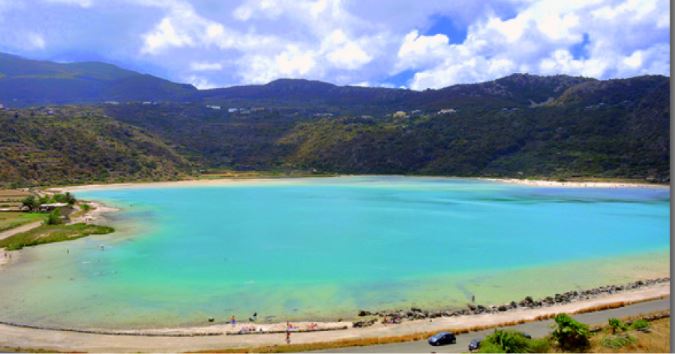 Between Sicily and Tunisia in the Mediterranean lies a secret hideaway of Europe’s rich and famous – the small Italian island of Pantelleria. Peaceful and quiet, the opposite of glitzy places like Ibiza, wealthy elite retreat here in luxurious yet very understated villas to get away from it all. It helps that the shoreline is all volcanic rock cliffs, which dissuades hordes of African “migrants” attempted to claim “asylum” in the EU welfare state by landing here.
Between Sicily and Tunisia in the Mediterranean lies a secret hideaway of Europe’s rich and famous – the small Italian island of Pantelleria. Peaceful and quiet, the opposite of glitzy places like Ibiza, wealthy elite retreat here in luxurious yet very understated villas to get away from it all. It helps that the shoreline is all volcanic rock cliffs, which dissuades hordes of African “migrants” attempted to claim “asylum” in the EU welfare state by landing here.
The most beautiful spot on Pantelleria is this volcano crater lake known as “The Mirror of Venus” – of such magic color that, the legend goes, the goddess Venus would admire herself in its reflection. Come here for a tranquil escape of your own. (Glimpses of Our Breathtaking World #164 photo ©Jack Wheeler)
THE GREEK GODS OF SICILY
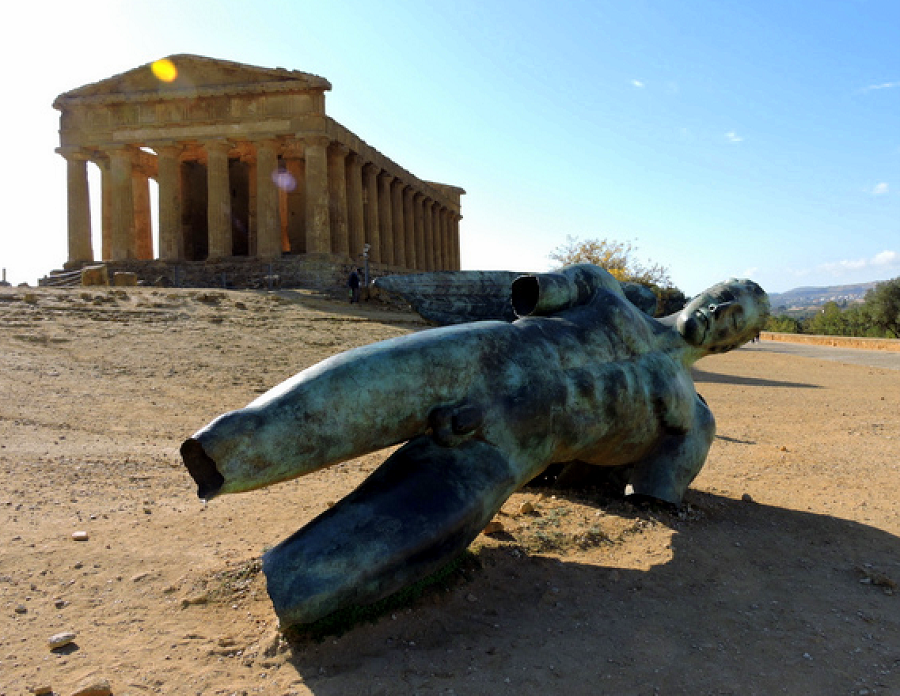 The Ancient Greeks began settling in the Mediterranean’s largest island around 750 BC. They called it Sikelia, after the Sikani and Sicel tribes that lived there. They flourished, building numerous cities, all with temples to their Olympian gods. The city of Akragas – now called Agrigento on the south coast – grew to a population of 200,000 by the 500s. It was here that the Greeks built the most outstanding examples of monumental Greek architecture that still exist today.
The Ancient Greeks began settling in the Mediterranean’s largest island around 750 BC. They called it Sikelia, after the Sikani and Sicel tribes that lived there. They flourished, building numerous cities, all with temples to their Olympian gods. The city of Akragas – now called Agrigento on the south coast – grew to a population of 200,000 by the 500s. It was here that the Greeks built the most outstanding examples of monumental Greek architecture that still exist today.
Along a ridge outside the city, they erected temples to Zeus, Hera, Heracles (Hercules) and many others. The one you see here the Romans called the Temple of Concordia (harmony), for by the time they showed up in the 200s, the Greek name was lost. In the foreground lies a remnant of a bronze statue to one of the Greek gods – perhaps Apollo. The glory that was Greece has been gone with winds of millennia. It can be a very emotional experience to be here.(Glimpses of Our Breathtaking World #248 photo ©Jack Wheeler)
LETHAL BEAUTY
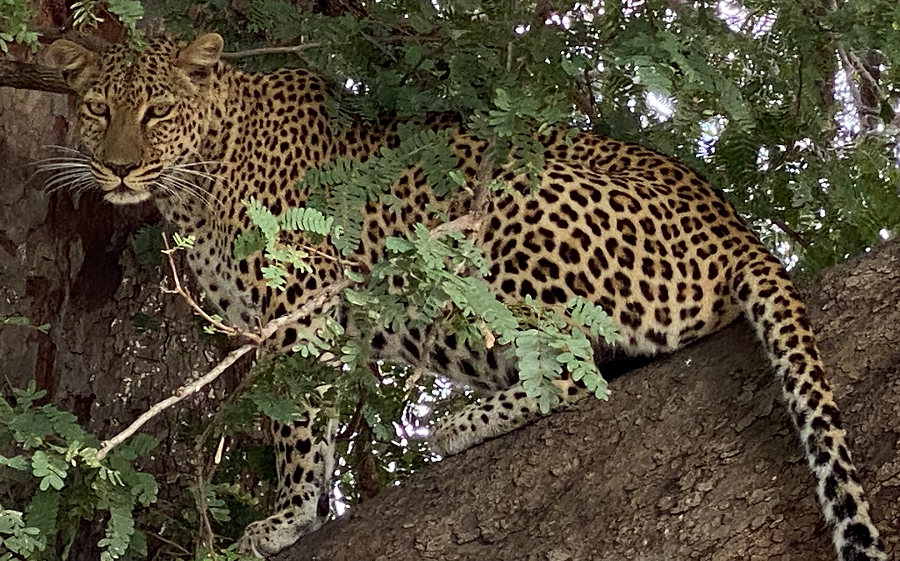 Want to get this close to a leopard – and safely? Come with me on a safari in Africa and I’ll show you how. Yes, she’s lethal – to the animals she hunts, not you. Yes, you can make such lethal beauty an indelible part of your life.
Want to get this close to a leopard – and safely? Come with me on a safari in Africa and I’ll show you how. Yes, she’s lethal – to the animals she hunts, not you. Yes, you can make such lethal beauty an indelible part of your life.
We really do only live once on this Earth. You really do owe it to yourself to make the most of it. You really can’t take it with you. It really is time to live your dream, to fill your soul with life-memorable experiences. Life lasts but a snap of the finger.
So what adventures have you always dreamed of? Let me know and maybe you and I can make them become real together. I’m only an email away: [email protected]. (Glimpses of Our Breathtaking World #204 photo ©Jack Wheeler)
THE PILLARS OF HERCULES
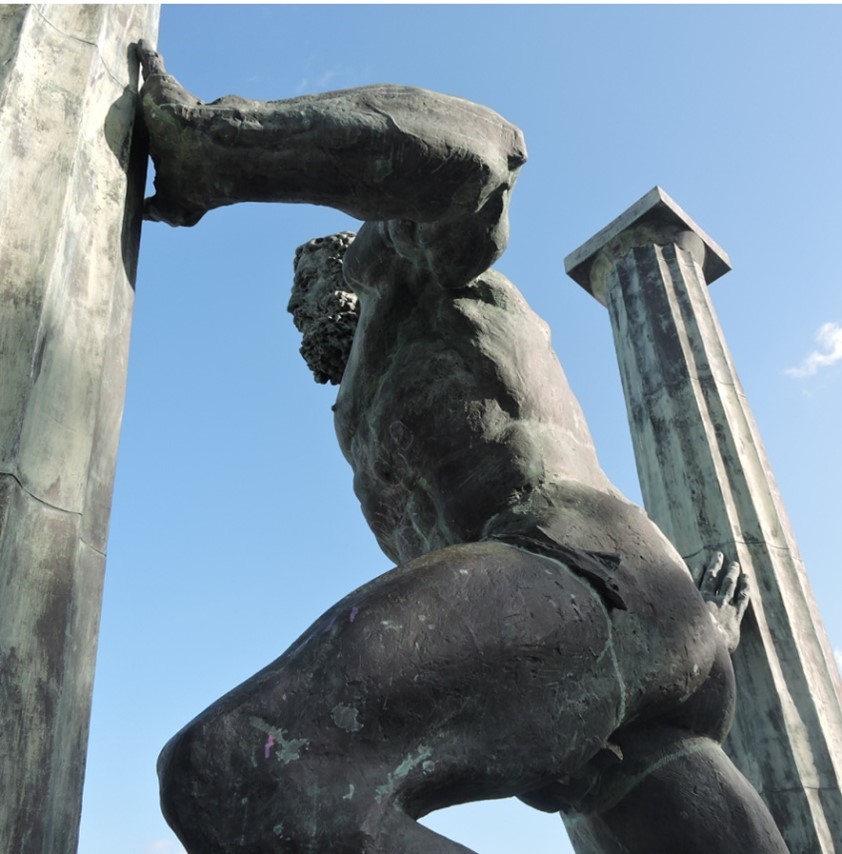 On either side of the entrance to the Strait of Gibraltar there are two small mountains known since great antiquity as the Pillars of Hercules. The pillar on the northern, European side is the famous Rock of Gibraltar. That on the southern, African side is Mount Abyla, Phoenician for “lofty mountain.”
On either side of the entrance to the Strait of Gibraltar there are two small mountains known since great antiquity as the Pillars of Hercules. The pillar on the northern, European side is the famous Rock of Gibraltar. That on the southern, African side is Mount Abyla, Phoenician for “lofty mountain.”
The legend for the Phoenicians, Greeks, and Romans was that Hercules pushed the two pillars apart to join the Mediterranean with the Atlantic. We think today of Hercules as a comic-book bodybuilder, while the truth is opposite. The entire ancient Mediterranean world very seriously worshipped him. For the Phoenicians, he was Melqart, King of the Earth. For the Greeks, he was Heracles, Divine Protector of Mankind. He was the same for the Romans, who pronounced his name as Hercules.
The Phoenician trading port of Abyla has a history of 3,000 years, from Phoenician to Carthaginian to Roman to Byzantine to Christian Visigoths to Islamic Berbers to Portuguese – and since 1668 to Spain, which continues to govern it today as the Spanish Autonomous City of Ceuta on the Mediterranean coast of Morocco.
Ceuta is a charming European city with beautiful beaches, open air cafés with great sangria, very relaxed and pleasant. It is here you find the statue of Hercules separating his Pillars commemorating the legend pictured above. Easy to get to with high-speed ferries from Algeciras near Gibraltar, Ceuta is definitely worth your while to experience. (Glimpses of Our Breathtaking World #137 Photo ©Jack Wheeler)
FLASHBACK FRIDAY: EXPLAINING THE WORLD WITH A SHRUNKEN HEAD
HALF-FULL REPORT 12/16/22
 Commie scumbag John Brennan, Obama’s CIA Director who was in charge of the Deep State/Twitter/Facebook et al war on Trump, Russia Hoax, Hunter Laptop suppression, and Dem theft of the 2020 presidency, ticked off the wrong guy.
Commie scumbag John Brennan, Obama’s CIA Director who was in charge of the Deep State/Twitter/Facebook et al war on Trump, Russia Hoax, Hunter Laptop suppression, and Dem theft of the 2020 presidency, ticked off the wrong guy.
Musk knows he has a lever that can move the world – that’s why he spent $44 billion buying it – and he plans to use it to kill off the Woke Mind-Virus.
There’s a lot of good news this week, like two silver linings right now. The first will make you smile, the second… a belly laugh.
There’s a Hurray! for two true American ladies you should know about this week. And one for the winner of this year’s Nobel Peace Prize. And another for a beauty queen turned deadly sniper known as her country’s Joan of Arc.
Here w go – lots to enjoy in this week’s HFR!
THE DEATH OF PAN
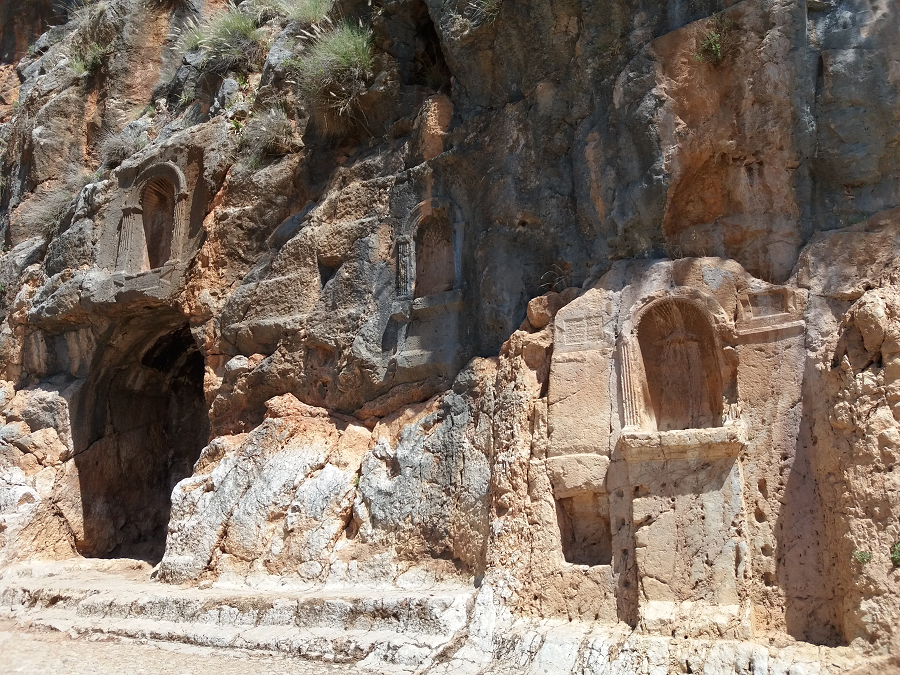 At the foot of Mount Hermon in northern Israel you find the Grotto of Pan, the Greek God of Nature, where pilgrims came from all over the ancient world to worship. Remnants of the huge Temple of Pan are here, together with the cave grotto where he lived when not at Olympus. The spring that gushes forth from the grotto is one of the sources of the Jordan River.
At the foot of Mount Hermon in northern Israel you find the Grotto of Pan, the Greek God of Nature, where pilgrims came from all over the ancient world to worship. Remnants of the huge Temple of Pan are here, together with the cave grotto where he lived when not at Olympus. The spring that gushes forth from the grotto is one of the sources of the Jordan River.
If Pan was ever disturbed, he would groan so loudly it would cause anyone who heard it to “panic” (panikos in Greek) – the origin of the term. Loudest of all was his last. The legend is that with the advent of Christianity replacing belief in the Olympian Gods, Pan died for lack of worshippers, emitting a death groan of agony from the mouth of the cave you see here so loud and terrifying it was heard throughout the Mediterranean. It’s a beautiful and peaceful place today. (Glimpses of Our Breathtaking World #51 photo ©Jack Wheeler)
WHO’S ‘WE’? “WE OWE US!” 2022
 This morning’s (12/15) Daily Mail has this story:
This morning’s (12/15) Daily Mail has this story:
Of course, no one on the committee asked – because they’re all ridiculous Lefties – the obvious question: “Who’s ‘we’?”
The people who worked for free as slaves lived over 160 years ago. The cammie coat guy sure doesn’t look that old, so who’s he talking about? Oh, he’s a descendant, the great-great-great-great-great-grandson (counting 25 years per generation) of someone who worked for free, so he gets to be a paid now. Right.
So here we go again. The Reparations Scam has been around so long that I wrote it up in TTP not quite 19 years ago, February 2004: We Owe Us! The Real Case for Reparations. Time to revisit and revise it. Feel quite free to send this to anyone you know who could benefit from it.
SKARA BRAE
North of Scotland are the Orkney Islands. On a windswept bluff above the North Atlantic, archaeologists have unearthed an intact Neolithic village of farmers and cattle herders that’s 5,000 years old (3200 BC) – centuries older than the Pyramids of Egypt. Their homes had beds, chairs, cupboards, flush toilets, running water, cozy, warm, and comfortable.
What you see here is just one section of the village. What I found particularly interesting was this sign at the entrance to the site.
These villagers enjoyed a warmer climate than today, more fertile land. Skara Brae is a 5,000 year-old refutation of the Global Warming Hoax. If you ever get to Scotland, be sure the Orkneys are on your itinerary. Skara Brae is only one of the places you’ll find fascinating. (Glimpses of Our Breathtaking World #210 photo ©Jack Wheeler)
THE MOST CHRISTIAN ISLAND
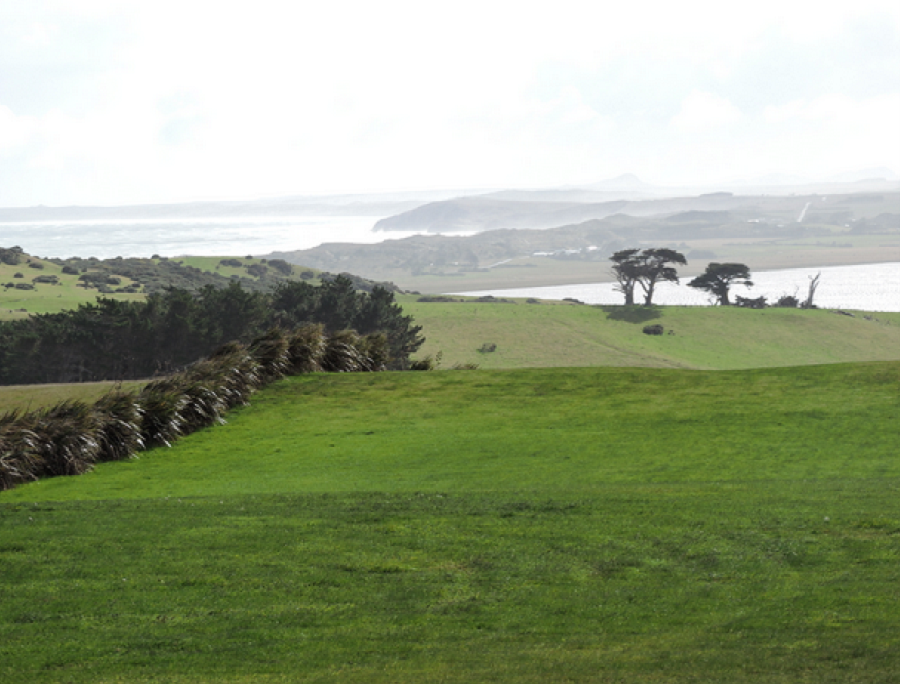 Waitangi Bay, Chatham Island. 530 miles east of New Zealand lies an isolated island of windswept rugged beauty that few people have ever heard of. Yet Chatham Island may be an ultimate Christian example of how to prevail over monstrous evil.
Waitangi Bay, Chatham Island. 530 miles east of New Zealand lies an isolated island of windswept rugged beauty that few people have ever heard of. Yet Chatham Island may be an ultimate Christian example of how to prevail over monstrous evil.
In the early 1400s, a Polynesian people calling themselves Moriori sailed from New Zealand across an unknown empty sea to reach an island they named Rekohu, meaning “misty sky.” For 400 years they lived in peace among themselves – and in utter isolation from the world.
But in 1835, another people arrived, and brought Hell with them. They were a group of 500 Maori cannibals from New Zealand determined to take Rekohu for themselves. The Maori killed them like sheep, men, women, children, and babies, and ate them.
The British Governor of New Zealand ignored the Maori Genocide. There were about 2,000 Moriori on Rekohu (renamed Chatham) when the Maoris arrived in 1835. Only 101 Moriori were still alive by 1862. It was Western Christian missionaries who put an end to Maori killing, eating, and enslaving Moriori. Today on Chatham Island there is a Moriori resurgence – but without rancor. The past is past, they say, what counts is the future. Like few other peoples on earth, the Moriori understand the Christian power of abandoning resentment and grievance.
Come to Chatham to experience a unique place in our world, and a people with their souls at peace. (Glimpses of Our Breathtaking World #176 photo ©Jack Wheeler)
SCANDERBEG
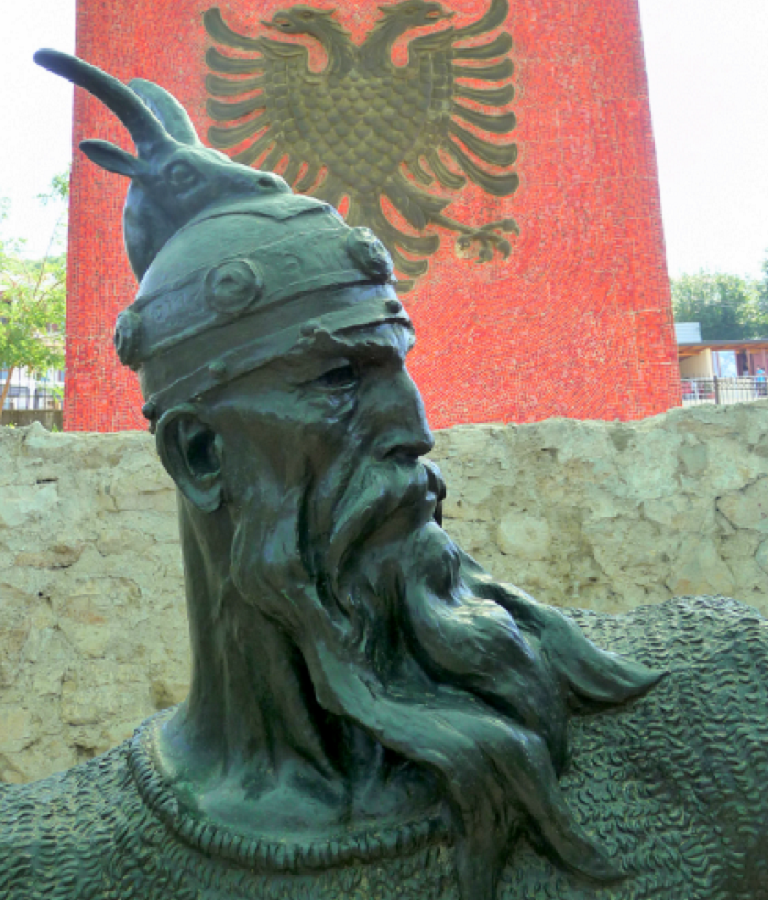 In the city of Lezhë overlooking the Adriatic Sea, there is a memorial to Albania’s national hero, Scanderbeg (1405-1468). Born Giorgi Kastrioti in this city of northern Albania, he earned the title of “Lord Alexander” – Scanderbeg in Albanian – for his military genius in leading his Christian army against the Moslem armies of the Ottoman Empire. For 25 years (1443-1468), his 10,000 Christian Knights consistently inflicted defeat after defeat upon always much larger Moslem forces.
In the city of Lezhë overlooking the Adriatic Sea, there is a memorial to Albania’s national hero, Scanderbeg (1405-1468). Born Giorgi Kastrioti in this city of northern Albania, he earned the title of “Lord Alexander” – Scanderbeg in Albanian – for his military genius in leading his Christian army against the Moslem armies of the Ottoman Empire. For 25 years (1443-1468), his 10,000 Christian Knights consistently inflicted defeat after defeat upon always much larger Moslem forces.
His victory in the Battle of Albulena in 1457, where he destroyed an Ottoman army of 70,000, killing 15,000 and taking 15,000 prisoners, so astounded all of Christendom that Pope Calixtus III appointed him Captain-General of the Holy See, and gave him the title of Athleta Christi, Champion of Christ.
By the 1500s with Skanderbeg but a memory, the Ottomans conquered Albania and Islamized it for almost 400 years. With the rise of Albanian nationalism in the late 19th century, Scanderbeg’s memory was revived. Today he is revered by Albanians who only ostensibly remain Islamic yet idolize a Christian King who devoted his life to defeating their country’s Moslem oppressors. (Glimpses of Our Breathtaking World #247 photo ©Jack Wheeler)
FLASHBACK FRIDAY: THE LOST CITY OF KUELAP
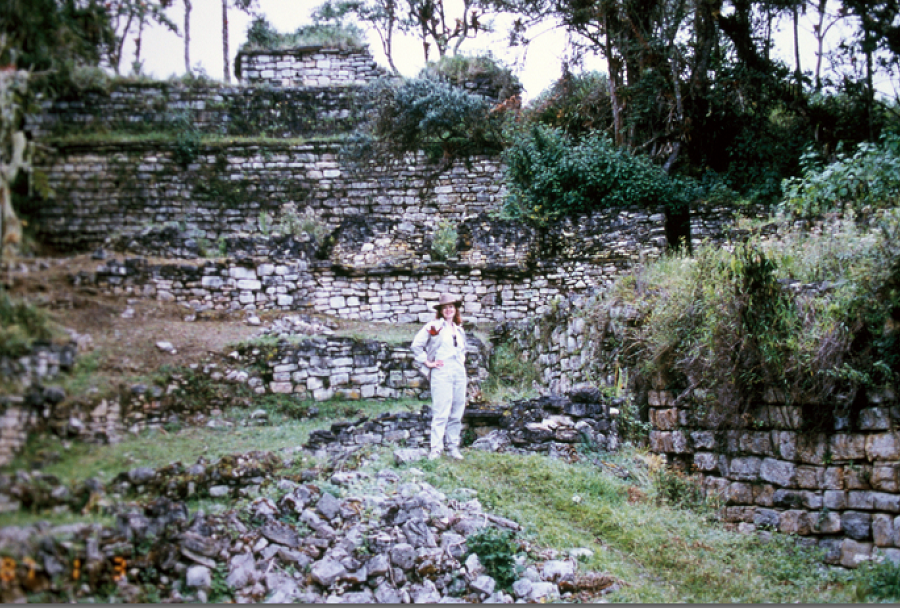 10,000 feet high in the Amazon cloud forests of northern Peru is a mysterious lost city built by an unknown people many centuries before the Incas existed. Known as Kuelap by villagers in the lowlands below, the Incas called the people who built it Chachapoyas, “Cloud Warriors.” I led an expedition here in 1994, climbing high up into the Amazon Andes to come upon gigantic stone walls 60 feet high surrounding hundreds of stone structures. Here you see Rebel among them. We’ll be here again in a year or two in another exploration of Peru. (Glimpses of Our Breathtaking World #153, photo ©Jack Wheeler)
10,000 feet high in the Amazon cloud forests of northern Peru is a mysterious lost city built by an unknown people many centuries before the Incas existed. Known as Kuelap by villagers in the lowlands below, the Incas called the people who built it Chachapoyas, “Cloud Warriors.” I led an expedition here in 1994, climbing high up into the Amazon Andes to come upon gigantic stone walls 60 feet high surrounding hundreds of stone structures. Here you see Rebel among them. We’ll be here again in a year or two in another exploration of Peru. (Glimpses of Our Breathtaking World #153, photo ©Jack Wheeler)
A LOO WITH A VIEW
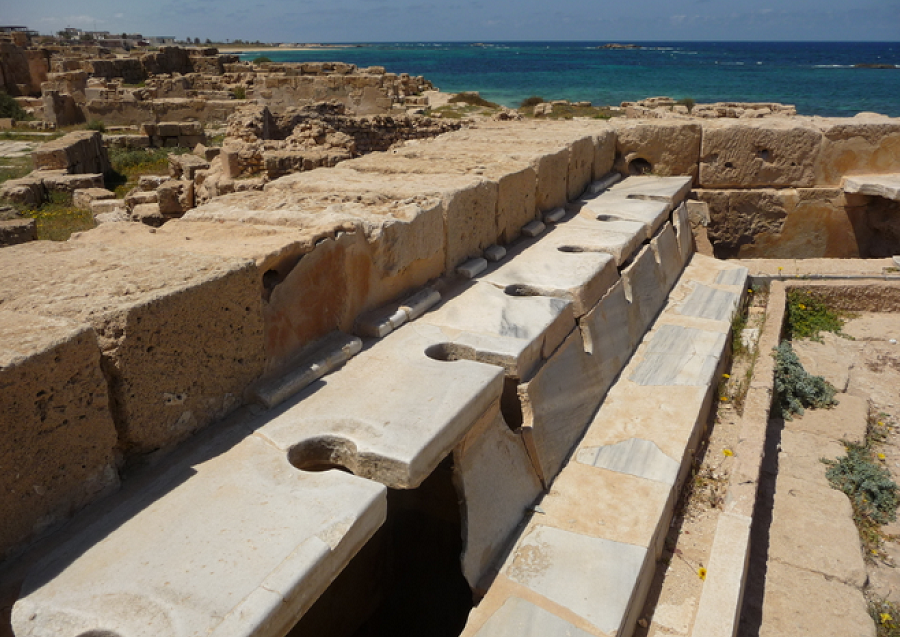 While exploring the Roman ruins of Sabratha on the Mediterranean coast of Libya in 2014, I came upon the men’s bathroom in the Gymnasium. “Now here’s a loo with a view!” I exclaimed, and noticed it was designed to have water flowing through the trough below the series of toilets.
While exploring the Roman ruins of Sabratha on the Mediterranean coast of Libya in 2014, I came upon the men’s bathroom in the Gymnasium. “Now here’s a loo with a view!” I exclaimed, and noticed it was designed to have water flowing through the trough below the series of toilets.
Founded as a trading post by the Phoenicians in the 6th century BC, it was settled and rebuilt by the Romans some 500 years later, flourishing for centuries as a main supplier of olive oil for the Empire. Monumental temples and theatres were constructed, along with sumptuous villas adorned with gorgeous mosaic floors. All of this has been excavated for the visitor to explore as a preserved UNESCO World Heritage Site.
It’s a shame Libya has collapsed into chaos now, for Sabratha and nearby Leptis Magna are among the most magnificent Roman ruins anywhere. One day the chaos will be over. (Glimpses of Our Breathtaking World #246 photo ©Jack Wheeler)

